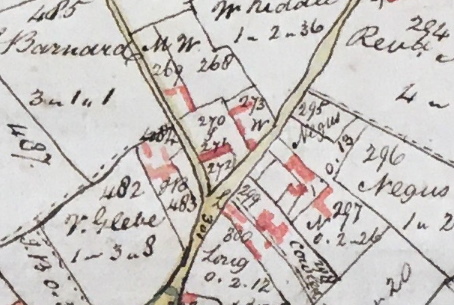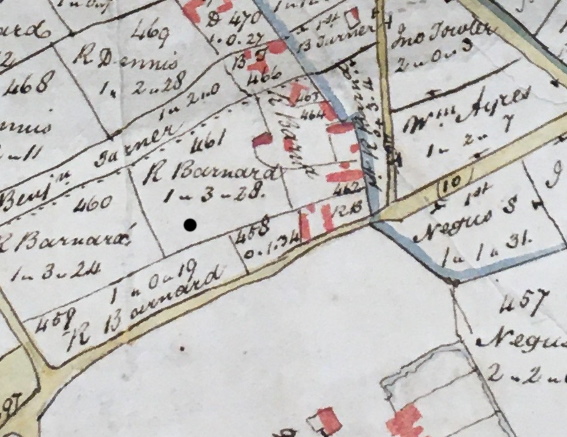In his will dated 1st August, 1777, John Barnard of Great Ellingham describes himself as a carpenter.

St James’s Church, Great Ellingham
Four years before making his will, John married Mary Mead in the Church of St James, Great Ellingham on the 22nd October, 1773. Mary Mead was a spinster of the parish of Eye in Suffolk, and John Barnard a widower of Great Ellingham.
John Barnard’s First Wife
John’s six year old son Charles (born about 1760) was baptised in the same parish church at Great Ellingham on the 1st January, 1766. The baptism register mentions that Charles was the son of John Barnard, a widower.
Accordingly, we know that John Barnard’s first wife had died prior to 1766. Unfortunately, the baptism entry does not reveal the name of Charles’s mother (John Barnard’s previous wife).
John Barnard mentions his two sons, Robert and Charles, in his will. From the will, we know that in 1777 Charles had not yet reached the age of 21 (he was in fact 17). Robert (the elder of his two sons), was over the age of 21 and, I suspect, aged around 27.
Martha Roper
I believe John Barnard was likely the John Barnard who married Martha Roper in Wymondham on the 10th October, 1749. For two reasons:
Firstly, on the 23rd August, 1750, John and Martha Barnard’s son Robert was baptised in the same parish church at Wymondham. I am confident that John’s son Robert is the Robert Barnard who married Frances Catton in Great Ellingham in 1782, and lived at Great Ellingham Hall. I mention later in this blog that John Barnard left certain property and land to his son Robert Barnard. I know that Robert Barnard of Great Ellingham Hall was indeed the owner of some of this land.
Secondly, Wymondham Town Archive holds certain abstracts of title (deeds) concerning properties in Wymondham, which refer to John Barnard, carpenter, of Great Ellingham and Wymondham.
John Barnard arrived in Great Ellingham with his sons Robert and Charles at some point after the baptism of Robert in Wymondham in 1750, but before Charles’s baptism in Great Ellingham in 1766.
Content of John Barnard’s Will
Five years after drawing up his will, John Barnard died. He was buried in the churchyard of St James’s Church on the 29th July, 1782.
Executors
In his will, he appointed ‘Mr John Barnard’ and his son Robert Barnard as his executors. I do not know the identity of this ‘Mr John Barnard’ but, of course, there is a good chance that the testator John Barnard and the executor ‘Mr John Barnard’ were related. Perhaps they were cousins?
Guardian
‘Mr John Barnard’ was also appointed as the guardian of Charles Barnard, should Charles not have reached the age of 21 on his father’s death. In the event, Charles Barnard was 22 when his father died.
Annuity for Widow Mary
John provided for his widow, Mary (née Mead) in his will. The will tells us that he had previously agreed (on their marriage) for the sum of £20 to be paid to Mary within six months of his death. However, John Barnard also provided that if Mary released his executors from this payment, the executors would pay Mary an annuity amounting to £12 per annum for the rest of her life.
Mary was also allowed to use ‘such part or parts of my household furniture plate linnon [linen] glass and china as Mr John Barnard one of my executors herein named shall think fit“. After Mary’s death, these items would pass to his son Charles.
Charles Barnard’s Inheritance
Charles Barnard inherited from his father:
- the sum of £320 which was charged upon the messuages and land which John Barnard bequeathed to his son Robert (who was also one of the executors). This sum was to be paid to Charles on him reaching the age of 21. John Barnard also provided that should Charles not attain the age of 21, then the £320 would be shared among any children of Charles “lawfully begotten“.
- all the tools and implements of his father’s carpentry trade as well as the stock of wood belonging to the business. This would suggest that Charles Barnard was also a carpenter.
- all the messuages, lands, tenements and hereditaments (in Great Ellingham) which John Barnard’s father had purchased from William Mallows and his wife. The will lists the names of all the occupiers of the various land and properties (as at 1777) as: James Webster, Thomas Duffield, Edward Lovett, Charles Thilthorpe, John Fox, Alice Sippens and Sarah Turrell (Tyrrell). This gift to Charles was subject to an annual rent charge of £4 towards the £12 annuity to be paid to John Barnard’s widow Mary.

Extract from 1802 Map of Great Ellingham. Original held at Norfolk Record Office. Russell James Colman Plans. Cat. Ref. C/Ca 1/84. With kind permission of NRO
The properties and land which John Barnard bequeathed to his son, Charles (by his will of 1777), are shown numbered 268, 269, 270 and 273 on the extract of an 1802 map of Great Ellingham. This includes the Chequer (or Chequers) public house (the position of which lies between numbers 269 and 270).
Charles also inherited:
- Four timber oak trees. These trees were on land which John Barnard left to his elder son, Robert.
Robert Barnard’s Inheritance
Eldest son Robert Barnard inherited from his father:
- The remainder of John Barnard’s messuages, lands, tenements and hereditaments which were subject to the £320 to be paid to Robert’s brother, Charles, and a rent charge of £8 being the remainder of the £12 annuity to be paid to his father’s widow, Mary Barnard (née Mead), during her lifetime. This inheritance was also subject to Charles Barnard selecting four timber oak trees which John Barnard directed to be taken as follows: three out of the parcel of land called ‘Home Meadow’ and one from the parcel of land called ‘the Great Turnpike Close’

Extract from 1802 Map of Great Ellingham. Original held at Norfolk Record Office. Russell James Colman Plans. Cat. Ref. C/Ca 1/84. With kind permission of NRO
A Particulars and Valuation of Great Ellingham of 1800 reveals a parcel of land numbered 461 to be ‘Home Meadow‘, and owned and occupied by Robert Barnard. The black dot on the above extract from an 1802 map of Great Ellingham identifies this parcel of land.
I should say that the Particulars and Valuation also reveals a further parcel of land called ‘Home Meadow’ at Bow Street. This ‘Home Meadow’ was also owned by Robert Barnard, although occupied by Robert Carlew (Carley). The document also mentions that this parcel of land was purchased by Robert Barnard from Jeffery Warren. Accordingly, I think it unlikely to be the parcel of land referred to as ‘Home Meadow’ in John Barnard’s will.
Robert also inherited:
- the remainder of his father’s personal estate, after the payment of the sum of £5 to Robert’s co-executor ‘Mr John Barnard’ “for his trouble and in token of my esteem for him“, and the settlement of his father’s debts and funeral & testamentary charges
Death of Widow Mary Barnard
John Barnard’s widow Mary survived her husband by 17 years. Mary Barnard (née Mead) was buried in the churchyard of St James on the 16th January, 1799. Mary also outlived her step-son, Charles Barnard, who died three years earlier in 1796.
Sources:
Wymondham Town Archive. ID 9613. Barnard, John. Carpenter. Great Ellingham, Norfolk & Wymondham, Norfolk
1741-1775 Great Ellingham Town Book. Norfolk Record Office. PD609/37
1800 Inclosure Commissioner’s Particulars and Valuation. Great Ellingham. Norfolk Record Office. Catalogue Ref: MC 2213/119, 941X7
Russell James Colman Plans. Norfolk Record Office. Catalogue Ref: C/Ca 1/84
Great Ellingham Parish Registers. Norfolk Record Office. PD/609. Also available at www.familysearch.org
Wymondham Parish Registers. Norfolk Record Office. PD184. Also available FreeReg website https://www.freereg.org.uk/
Abstract of Title. Wymondham Town Archive. Reference 11773. John Gall Jnr. Lands in Great Ellingham sold to Wm Rose on 1/11/1842
1783 Will. Barnard, John, carpenter of Gt Ellingham. NCC will register Buck 118